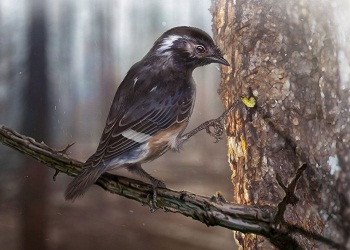The Cretaceous Period flier, trapped in amber 99 million years ago, had features unlike any bird living today.
Some 99 million years ago, a small animal with a weird elongated toe died and became partially entombed in amber. Its lower leg and foot remained undisturbed in the hardened tree resin until amber miners eventually discovered the fossil
The preserved toe measures less than half an inch from knuckle to claw-tip, making it 41 percent longer than the next longest digit on the animal’s foot. When traders showed the curious specimen to Chen Guang, a curator at China’s Hupoge Amber Museum, they suggested that it probably belonged to an extinct lizard.
A handful of Cretaceous bird fossils have been found in Burmese amber, but this is the first to be identified as a new species. Named Elektorornis (“amber bird”) chenguangi.
E. chenguangi was smaller than a modern sparrow and belonged to a family of birds called Enantiornithes, which was abundant during the Cretaceous period.
Its elongated toe structure has never been observed in other birds, living or extinct. Its foot also sported an unusual layer of bristled feathers, “unlike any adult bird known today,”
Long toes are associated with arboreal animals that need a firm grip on tree branches. The bristles suggest that the bird’s foot also had a sophisticated sensory system. Dr. Xing’s team speculated that E. chenguangi may have used the long, sensitive digit to probe cracks in trees for insects and grubs, just as the aye-aye lemur uses a slim finger to extract food in modern Madagascar.
These sorts of special adaptations may have helped propel Enantiornithes to evolutionary success during the age of dinosaurs. At that time, Enantiornithes overshadowed Neornithes, the group that contains all modern avian species. But that abruptly changed when a huge asteroid hit Earth 66 million years ago.
Enantiornithes were wiped out along with the non-avian dinosaurs, while Neornithes went on to become the diverse group of birds from ostriches to penguins, eagles to hummingbirds that currently inhabits our planet.
Enantiornithines were good enough to survive and dominate in the Cretaceous but maybe not good enough to make it through the mass extinction, She noted that the faster maturation cycles and more efficient digestive systems of Neornithes may have given them an edge.
Enantiornithines may no longer be with us, but this amber fossil has provided a sepia-toned snapshot of their lives and their world.
While many fossils trapped in amber like this one are reshaping our understanding of the distant past, they may also be amplifying intractable social tensions in Myanmar in the present.
Some of these specimens have big price tags, and that money might in some cases help fund armed conflict in Myanmar between the government and militias.
These fossils are hugely important, and the scientists studying them have done an excellent job, but I want to be sure that these fossils were not incidentally complicit in human suffering.
Lara Khouli.

